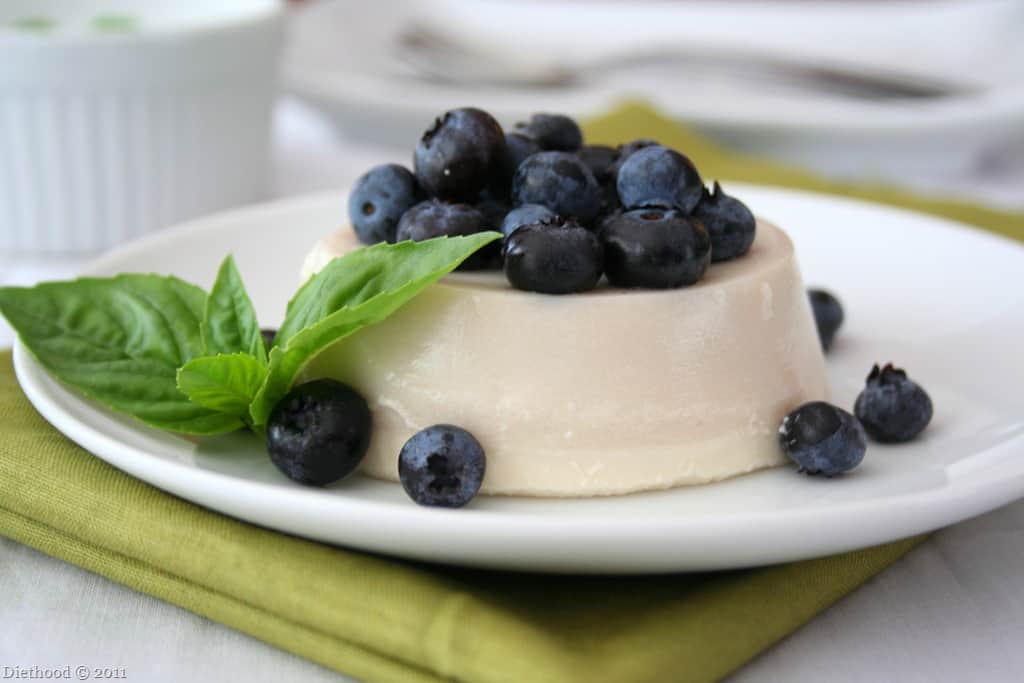This post may contain affiliate links. Please read our disclosure policy.
Cool, creamy, and just a little fancy, this sweet basil panna cotta is the no-bake dessert I reach for when I want to impress with minimal effort. Made with fresh basil and cream, it’s silky smooth and sweet.

Why You’ll Love This Panna Cotta Recipe
- Easy to make. This dessert looks like you spent all day on it, but it’s actually one of the easiest things you can make ahead.
- Fresh. The fresh sweet basil gives it a subtle herbal twist that’s refreshing and unique, perfect for spring or summer.
- No bake. And since there’s no baking involved, it’s a no-sweat dessert you can pull off with your eyes closed!
What Is Panna Cotta?
Panna cotta is a classic Italian dessert that literally means “cooked cream.” It’s made by gently heating cream and milk with sweetener and gelatin, then letting it chill until set. The result is a smooth, custard-like dessert that’s cool, creamy, and effortlessly elegant.

Ingredients You’ll Need
- Heavy cream – For richness and that smooth, velvety texture.
- Fresh basil – Adds a slightly sweet, earthy flavor that balances the creaminess.
- Erythritol or granulated sugar – Your call! I used erythritol and stevia, but regular sugar works perfectly.
- Almond milk or whole milk – To lighten things up just a bit.
- Unflavored gelatin – This sets the panna cotta. I use two envelopes.
- Stevia (optional) – If using erythritol, I like to add a few drops of stevia for more sweetness.

How To Make Panna Cotta
- Simmer and steep. Simmer the heavy cream, basil, and sugar. Remove it from the heat and let it steep for 30 minutes.
- Strain and prep ramekins. Pour the mixture through a fine-mesh sieve into a bowl. Lightly grease six ¾-cup ramekins or custard cups.
- Bloom the gelatin. In a separate saucepan, add the almond milk and sprinkle the gelatin over the top. Let it sit so the gelatin can bloom.
- Dissolve the gelatin. Add the remaining almond milk and set the pan over medium heat. Stir constantly and cook just until the gelatin dissolves. Remove from the heat and stir in the steeped cream mixture.
- Chill to set. Divide the mixture evenly between the ramekins. Cover with plastic wrap and refrigerate until fully set, at least 4 hours.
- Unmold and serve. Serve straight from the ramekins, or to unmold, dip the bottoms in warm water for 30 seconds, run a knife around the edge, and flip onto a plate. Top with your favorite berries or homemade strawberry sauce and serve.
Recipe Tips & Variations
- Strain it for smoothness. Straining the cream mixture after steeping the basil isn’t required, but it helps remove any air bubbles or stray basil bits so your panna cotta comes out silky smooth.
- Don’t rush the chill. Let it chill at least 4 hours, but overnight is even better. If you try to unmold it too soon, it won’t hold its shape.
- Make a classic panna cotta. Use vanilla extract instead of herbs for a more traditional flavor.
- Flavors. Swap basil for mint, lemon zest, or lavender for a different vibe.
- Toppings. Serve with blueberries, strawberries, raspberry compote, or even a drizzle of honey or balsamic glaze.

Make-Ahead and Storage
This is one of my favorite desserts to make ahead because it keeps beautifully!
- Refrigerate: Cover the ramekins tightly with plastic wrap and refrigerate for up to 3 days. Add toppings or berries just before serving.
- Freezing: Not recommended. Freezing can mess with the texture and make it grainy
Tools I Used
(Amazon affiliate links) – Check out my kitchen shop here.
- Saucepan – One for the basil cream, one for the gelatin milk mix.
- Fine-mesh sieve – For straining out the basil and getting that smooth finish.
- Ramekins – I use ¾ cup ramekins, but small jars or cups work too.
- Measuring cups – To keep things accurate.
Pin this now to find it later
Pin It
Panna Cotta Recipe
Ingredients
- 1½ cups heavy cream
- ¼ cup fresh basil, chopped
- ¼ cup granulated erythritol*, or ½ cup granulated sugar
- 1½ cups almond milk, or use whole milk
- 2 envelopes unflavored gelatin, (4½ teaspoons)
- 16 drops stevia extract, (omit if using granulated sugar)
Instructions
- Prep the ramekins. Lightly grease six 3/4 cup ramekins or custard cups.
- Simmer and steep. Combine the heavy cream, basil, and erythritol (or sugar) in a medium saucepan over medium heat. Bring to a boil, then remove from heat and let steep for 30 minutes.
- Strain. Pour through a fine-mesh sieve into a bowl to remove solids. Press on the solids to release as much flavor and liquid as possible.
- Bloom the gelatin. Pour 1/2 cup of the almond milk (or whole milk) into another medium saucepan. Sprinkle the gelatin over and let it sit for 3 minutes.
- Whisk and cook. Whisk in the remaining almond or whole milk, set over medium heat, and cook, stirring constantly. Cook until the gelatin dissolves and steam begins to rise from the milk, but do not boil. Remove from the heat and gently stir the heavy cream mixture into the milk mixture. If using stevia, stir it in now.
- Chill to set. Divide the mixture between the ramekins and cover each one with plastic wrap. Refrigerate until chilled and set, about 4 hours or overnight.
- Unmold and serve. To unmold, set the bottom of each ramekin in hot water for 30 seconds. Run a sharp knife around the inside of each ramekin to loosen and flip out onto the plate. I found it took a little jiggling to get the panna cotta to come free. You can also serve it straight from the ramekins.
- Serve. Top with your favorite sauces or berries and serve.
Notes
Nutrition
Nutritional info is an estimate and provided as courtesy. Values may vary according to the ingredients and tools used. Please use your preferred nutritional calculator for more detailed info.









Hi! First of all, this looks amazing, and I would love to make some panna cotta. Secondly, I’m curious as to what kind of basil this is as I’m trying my best to learn the (rather confusing, but important) distinction between them. These leaves don’t look like the leaves from my sweet basil plant, which are a little rounder. Do you know exactly what kind of basil this is? There are likely better choices for a dessert basil than the common Italian varieties, and I would love to experiment with them.
Never cooked with almond milk. I am intrigued by these beautiful pics.